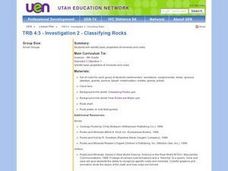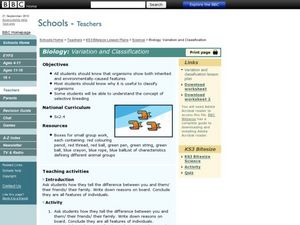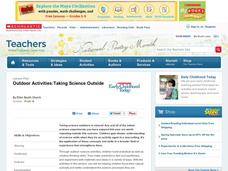Curated OER
Why Cladistics?
Students explore how biological classification is intimately associated with evolution.
Curated OER
Leaf - It's What's for Dinner
Learners discover correlations in food preferences of invertebrates, and assess stream health through use of kicknets, invertebrate keys, CBL systems and probes.
Curated OER
Classification of Clouds
Students view a cloud slide show presentation and identify types of clouds. They estimate height based on cloud's appearance. They discuss the vague nature of cloud nomenclature and compare it to the English standard measurement system.
Curated OER
Shell Sort; Serving up Seafood
Students complete various small group activities to classify items and determine the types of combinations that can be made with these items. In the second lesson, students create menus for a restaurant to help them gain money sense and...
Curated OER
Classification 2: A Touch of Class
Young scholars examine how many kinds of living things (e.g. plants and animals) can be sorted into groups in many ways using various features to decide which things belong to which group and that classification schemes vary with purpose.
Curated OER
Weights in Pounds
Second graders define "pound," estimate and compare weights, and classify objects as weighing more or less than a pound.
Curated OER
Iron in Cereal
Students use a small magnet to remove particles of iron from common breakfast cereal.
Curated OER
Take A Walk On The Wildside
Students study big cats in a variety of lessons included in this unit.
Curated OER
Investigation 2 - Classifying Rocks
Fourth graders identify basic properties of minerals and rocks. They access websites and utilize worksheets imbedded in this lesson to further their understanding of rock classification.
Curated OER
Classify UT Plants and Animals
Students practice using 2 different plant classification keys to identify species. They make choices between the similarities and differences between their object and the classification scheme.
Curated OER
Classification Schemes
Students place organisms into the correct classification and justify their reasoning. They must include all objects and have a reason for their decisions.
Curated OER
WHAT, IF ANYTHING, IS A ZEBRA?
Students read the essay, "What, If Anything, Is a Zebra?" following a teacher made reading guide. They investigate cladistics, shared derived characteristics, with further online research to enhance their study of evolution and...
Curated OER
Going On A Picnic
Students classify items you would bring on a picnic into different categories. In this sorting lesson plan, students have categories of food, table things, and toys. A simple lesson that teaches an important skill.
Pennsylvania Department of Education
Alike and Different
Students compare and contrast objects and are introduced to a Venn Diagram. In this alike and different instructional activity, students make observations regarding properties of objects. Students classify object and build ideas about...
Curated OER
Climate in the Western Regions
Students examine the interactions of the Earth's systems and other objects in space. In this climate change lesson students study the pros and cons of different climates and what their preferences are.
Curated OER
Tree-Mendous!
Students classify trees. In this tree-mendous lesson, students categorize a variety of trees to assist them in playing a Jeopardy like game. Students identify new vocabulary terms and classify the uses and benefits of trees for humans.
Curated OER
Biology: Variation and Classification
Students investigate classification of different animal groups. In this biology instructional activity students list characteristics of themselves and others they know to show differences and how they are classified. Students then answer...
Curated OER
Outdoor Activities: Taking Science Outside
Students participate in various outdoor science activities to enhance their observation, classification, and analysis skills. In this outdoor lesson, students begin by observing a tree from a straightforward angle, then from the...
Curated OER
Taxonomy and the World of Microorganisms and Viruses
In this taxonomy activity, learners understand how organisms are classified using Linnaeus' system. Students classify organisms as either plant or animal. This activity has 24 fill in the blank and 6 matching questions.
Curated OER
Classification of Organisms
In this classification activity, learners complete a crossword puzzle with 17 clues about vocabulary pertaining to the classification of organisms.
Curated OER
Begin with Buttons
Students utilize buttons to explore logical and numerical relationships. They focus on the two basic logical thinking skills, classification and seriation. Each student applies these developing skills to the operations of addition and...
Curated OER
Insect Book
Fifth graders select an insect and create a page for an Insect ABC book to display their research. They choose an insect from a given letter of the alphabet and use KidPix to illustrate. They write 2-3 sentences describing their insect...
Curated OER
One-Difference Classification Train
Students practice their classification skills through hands-on practice. Working in groups, students identify various ways in which similar items can be classified. Given a kit of similar items, students classify objects in multiples...
Curated OER
Exploring Alaska Foilage In Russian
Seventh graders investigate the concepts of how plants are part of daily culture in Russia. The skills of naming different plants is practiced. Students take a survey of the nature that is found in the area in which they live. This is...

























